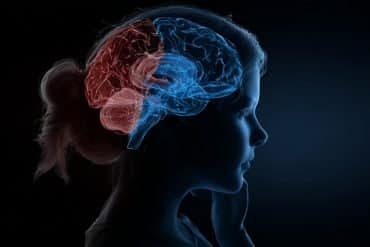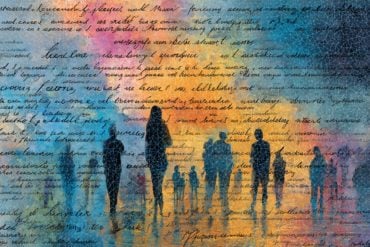Summary: Researchers have created a new model that may help explain how different sleep patterns may help us to solve problems. The study reveals non-REM sleep helps us categorize information, where as REM sleep helps us to draw unexpected connections between information we have been exposed to.
Source: Cell Press.
Sleep is known to be important for creative thinking, but exactly how it helps and what role each sleep stage–REM and non-REM–plays remains unclear. A team of researchers have now developed a hypothesis, outlined in an Opinion published May 15 in the journal Trends in Cognitive Sciences, to explain how the interleaving of REM and non-REM sleep might facilitate creative problem solving in different but complementary ways.
“Suppose I give you a creativity puzzle where you have all the information you need to solve it, but you can’t, because you’re stuck,” says first author Penny Lewis, a professor at the Cardiff University School of Psychology. “You could think of that as you’ve got all the memories that you need already, but you need to restructure them–make links between memories that you weren’t linking, integrate things that you weren’t integrating.”
Studies show that this kind of restructuring often happens while we are asleep, so Lewis and her co-authors drew on that literature, as well as physiological and behavioral data, to create a model of what might be happening during each stage. Their model proposes that non-REM sleep helps us organize information into useful categories, whereas REM helps us see beyond those categories to discover unexpected connections.
According to previous research, memories captured by the hippocampus are replayed during non-REM sleep, and as we detect similarities between them, that information gets stored in the cortex. Because the hippocampus and cortex are in close communication during this stage, Lewis and her co-authors propose that the hippocampus somehow controls what is replayed. Because it prefers to replay things that are similar or thematically linked, it encourages us to find those links and use them to form schemas, or organizing frameworks.
During REM sleep, on the other hand, the hippocampus and cortex don’t appear to be nearly as in sync. So, Lewis’s team suspects that the cortex is now free to replay stored memories in any combination, regardless of whether they are similar. Meanwhile, evidence suggests that ponto-geniculo-occipital waves cause areas of the cortex to randomly activate, which could trigger the replay of memories from different schemas.
“So, what we propose is that, if you’re stuck on some kind of problem, that problem is salient, and we know that salient things are replayed,” Lewis says. “The slightly hypothetical part is that, when something else is randomly activated in the cortex that has an element that’s similar, you’ll form a link.” These surprising links may be the creative leaps required to solve a problem.

To illustrate, she refers to Earnest Rutherford’s discovery of the structure of an atom. He based his design on something that might seem unrelated: the solar system. According to the model that Lewis and her team propose, Rutherford’s knowledge of atoms and solar systems would have been categorized into different schemas during non-REM sleep. Then, during REM sleep, his memories of atoms could have been replayed along with a randomly activated memory of the solar system, allowing him to detect the overlap between them and, later, apply it to his work.
“The idea is to lay out this model in a formal way so that it’s there and people can explicitly test it,” Lewis says. Having received a five-year grant, she and her team are already at work on their own testing and look forward to sharing the results.
Funding: The authors are supported by the European Research Council, EPSRC, Cardiff University, UCLA, and the National Institutes of Health.
Source: Kelly McClorey – Cell Press
Publisher: Organized by NeuroscienceNews.com.
Image Source: NeuroscienceNews.com image is in the public domain.
Original Research: Open access research for “How Memory Replay in Sleep Boosts Creative Problem-Solving” by Penelope A. Lewis, Günther Knoblich, and Gina Poe in Trends in Cognitive Sciences. Published May 14 2018.
doi:10.1016/j.tics.2018.03.009
[cbtabs][cbtab title=”MLA”]Cell Press “How REM and Non-REM Sleep May Work Together to Help Solve Problems.” NeuroscienceNews. NeuroscienceNews, 15 May 2018.
<https://neurosciencenews.com/rem-nrem-problem-solving-9049/>.[/cbtab][cbtab title=”APA”]Cell Press (2018, May 15). How REM and Non-REM Sleep May Work Together to Help Solve Problems. NeuroscienceNews. Retrieved May 15, 2018 from https://neurosciencenews.com/rem-nrem-problem-solving-9049/[/cbtab][cbtab title=”Chicago”]Cell Press “How REM and Non-REM Sleep May Work Together to Help Solve Problems.” https://neurosciencenews.com/rem-nrem-problem-solving-9049/ (accessed May 15, 2018).[/cbtab][/cbtabs]
Abstract
Corticoinsular circuits encode subjective value expectation and violation for effortful goal-directed behavior
It is commonly accepted that sleep promotes creative problem-solving, but there is debate about the role of rapid eye movement (REM) versus non-REM sleep.
Behavioural evidence increasingly suggests that memory replay in non-REM sleep is critical for abstracting gist information (e.g., the overarching rules that define a set of related memories).
The high excitation, plasticity, and connectivity of REM sleep provide an ideal setting for the formation of novel, unexpected, connections within existing cortically coded knowledge.
The synergistic interleaving of REM and non-REM sleep may promote complex analogical problem solving.
Creative thought relies on the reorganisation of existing knowledge. Sleep is known to be important for creative thinking, but there is a debate about which sleep stage is most relevant, and why. We address this issue by proposing that rapid eye movement sleep, or ‘REM’, and non-REM sleep facilitate creativity in different ways. Memory replay mechanisms in non-REM can abstract rules from corpuses of learned information, while replay in REM may promote novel associations. We propose that the iterative interleaving of REM and non-REM across a night boosts the formation of complex knowledge frameworks, and allows these frameworks to be restructured, thus facilitating creative thought. We outline a hypothetical computational model which will allow explicit testing of these hypotheses.







